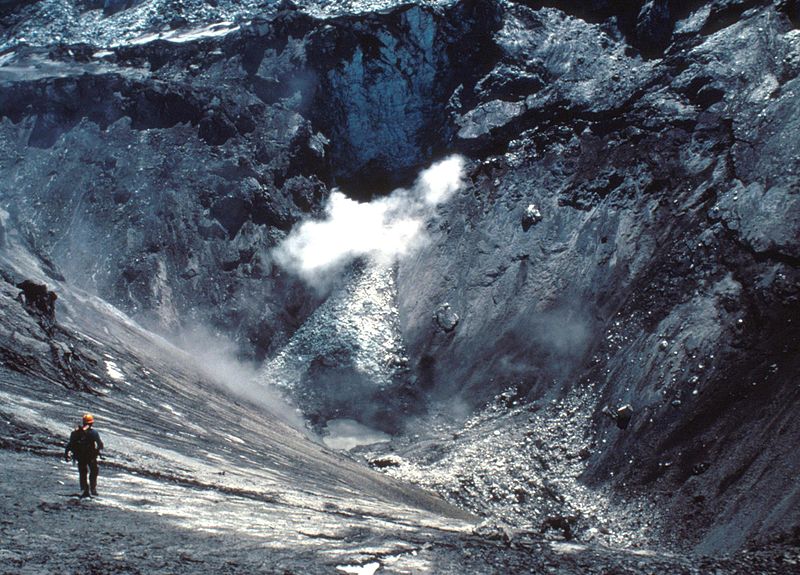Dedication: The Geologists Who Died at Mount St. Helens
May 30, 2012 |
Dr. David Johnston's always there, on the volcano where he died. He was among the first geologists on the ground when Mount St. Helens woke up in March of 1980. He was a constant presence in the media. Dedicated and enthusiastic, bearded and grinning, completely at home with the hazards, he exemplified the ideal vulcanologist. Wes Hildreth, who had worked with him in the past, summed him up: "Dave's agility, nerve, patience, and determination around the jet-like summit fumaroles in the crater of Mt. Mageik were to me a spectacle of unforgettable beauty."

Dr. David A Johnston posing with a rhyolite dome in the Valley of Ten Thousand Smokes, Alaska, in June 1978. Image Credit: USGS
He had an enormous impact on the USGS. He'd only been working there for two years when he died, yet he'd already earned the respect and admiration of his colleagues. It shines through in so many places: the volcano observatory named for him, the dedication at the beginning of the USGS professional paper "The 1980 Eruptions of Mount St. Helens," and those unexpected tributes scattered through the literature. Robert Christiansen and Donald Peterson, in their "Chronology of the 1980 Eruptive Activity," devoted most of their acknowledgments section to him: "Among the many contributors of data, none was more essential to the systematic reconstruction of the events of 1980 at Mount St. Helens than David Johnston, to whose memory this report is dedicated. Dave, who was present through all of the activity up to the climactic eruption and who lost his life in that eruption, provided far more than data. His insights and his thoroughly scientific attitude were crucial to the entire effort; they still serve as a model for us all."
I will admit this: I cry. Every time. Every time I catch sight of the geologist he was, and realize anew what we lost that day, I tear up. He furthered our knowledge; he saved lives by being one of the voices saying that St. Helens was still dangerous even when she fell briefly quiet. He demonstrated an ability to bring science to the public as he spoke to the media regarding her antics. He was an amazing man, a hell of a geologist, and he'll never be forgotten: not just because he died on the mountain that day, but because he was so very good at what he did.

Dave Johnston going into Mount St. Helens crater to sample lake (from west). Crop of original photo by R.P. Hoblitt. Skamania County, Washington. April 30, 1980. Image Credit: Wikimedia Commons
Dave wasn't the only geologist killed in the May 18th eruption.
PhD candidate James F. Fitzgerald, Jr was camped on Spud Mountain, a few miles northwest of the volcano. His friend Trixie Anders, a vulcanologist working on her PhD at University of Washington, had invited him to join her and her husband, Barry Johnston, at their campsite. He chose to stay there on the night of May 17th while Trixie and Barry stayed at a hotel in Toutle. He'd been doing fieldwork for his dissertation, and this must have been the opportunity of a lifetime for a vulcanologist on the verge of earning his doctorate. He had joined the AGU in 1978, becoming a student member of the Volcanology, Geochemistry, and Petrology section. He was just 32 years old when the mountain blew. Trixie and Barry were on their way up to join him: they barely made it out ahead of the ash cloud. Jim's body was later recovered, and Trixie ensured a memorial was erected to him. He was awarded his PhD posthumously by the University of Idaho, and a scholarship is endowed in his name.
Robert "Bob" Kaseweter (spelled Kasewater in some reports) and Beverly Wetherald were amateur vulcanologists. Bob had a cabin at Spirit Lake, and he and Beverly were allowed to stay there, within the red zone. Marian T. Place, in her book Mount St. Helens: A Sleeping Volcano Awakes, described Bob as "a young Portland geologist." He "was permitted to remain in his A-frame cabin on the lakeshore because he had a battery-operated seismograph there and was shooting a timed series of photographs of the volcano." He kept the car ready for a quick escape, but when the north flank failed, the avalanche buried them both within moments. Bob was 39; Beverly was 35.
Dedication is a multi-faceted word. All four vulcanologists exemplified one of its meanings: they were dedicated to their work. They knew it was dangerous. They knew there was a possibility they could lose their lives. But they knew the work was important. They, along with many others, took the necessary risks to further our understanding of volcanoes. They died doing what they loved. And they will never be forgotten.
Their names are engraved on the memorial at Johnston Ridge Observatory.
This series is dedicated to them.
--
Zenguins!
Vei8-Volcanoes of the World Webcams
Roxxfoxx~~Adventures in Geology
Penguin News Today
Penguinology: The Science of Penguins
Gentoo Penguins of Gars O'Higgins Station, Antarctica
Canis lupus 101
Dances with Werewolves
Through Golden Eyes
Change settings via the Web (Yahoo! ID required)
Change settings via email: Switch delivery to Daily Digest | Switch to Fully Featured
Visit Your Group | Yahoo! Groups Terms of Use | Unsubscribe





No comments:
Post a Comment